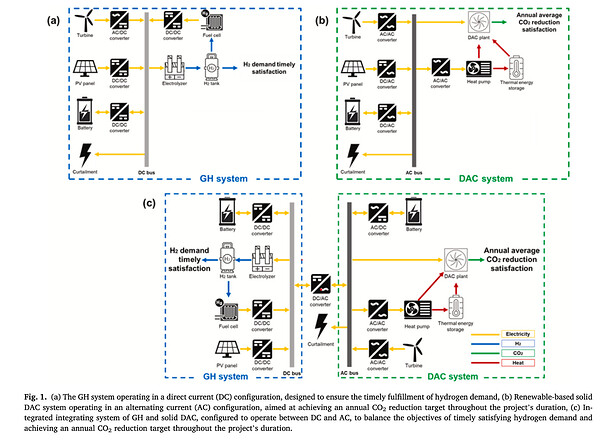Integrating solid direct air capture systems with green hydrogen production: Economic benefits and curtailment reduction
This week, we take a deep dive into a paper recently published in Computers & Chemical Engineering. The study was led by Sunwoo Kim, from the Mork Family Department of Chemical Engineering and Material Sciences of the University of Southern California, in Los Angeles (USA).
The paper explores the integration of solid direct air capture (DAC) systems with green hydrogen production to evaluate their economic benefits and impact on curtailment reduction. Presenting a detailed analysis of the synergies between DAC and green hydrogen processes, the study highlights how their combination can enhance efficiency and reduce the costs associated with both technologies.
Green hydrogen (GH), produced via water electrolysis powered by renewable energy, is a key clean energy carrier. However, the GH supply chain often experiences significant electricity curtailment, compounded by the intermittency of renewable energy and the high electricity demand of GH systems—up to 50 times greater than conventional steam methane reforming. To address this issue, integrating GH production with complementary technologies that can effectively utilize curtailed electricity offers a promising solution. This study explores the integration of GH production with direct air capture (DAC) technology to mitigate electricity curtailment challenges. In particular, the study examines five distinct systems: a standalone GH system, a standalone solid DAC system, and three configurations in which these systems are integrated. Each system relies on wind turbines and photovoltaic panels to convert wind and solar energy into electricity and handles energy storage through batteries, hydrogen tanks, and thermal energy storage.
The results show that integrating direct air capture (DAC) with green hydrogen (GH) production can reduce curtailed renewable energy by up to 40%, leading to a 6% reduction in total annualized costs compared to independent operation. Further economic gains are achievable by optimizing the CO2 capture-to-H2 production ratio, leveraging expected cost reductions in DAC technology, and improving heat pump flexibility. With a 50% reduction in DAC costs, an optimized CO2-to-H2 ratio, and enhanced heat pump performance, economic benefits could increase from 6% to 12%, highlighting the significant potential of this integrated approach.
Here is a list of the main takeaways from this paper:
- Combining green hydrogen production with direct air capture (DAC) reduces curtailed renewable energy by up to 40%.
- The integrated approach results in a 6% reduction in total annualized costs compared to independent systems.
- Optimizing the CO2 capture-to-H2 production ratio and enhancing system flexibility further improve economic outcomes.
- A 50% reduction in DAC costs could increase economic benefits from 6% to 12%.
- The integrated system offers a pathway to scaling both carbon capture and green hydrogen production, supporting climate targets.
Read the full paper here: Integrating solid direct air capture systems with green hydrogen production: Economic benefits and curtailment reduction
